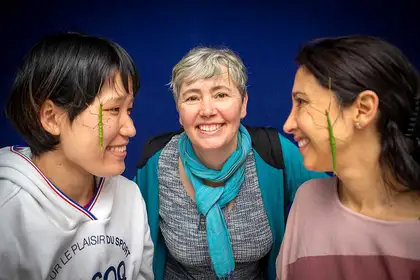
Master’s student Mari Nakano, Professor Mary Morgan-Richards and Dr Andrea Clavijo McCormick.
Massey University researchers have discovered more about the sexual lives of stick insects in New Zealand and the United Kingdom.
The research draws from two papers led by Professors Mary Morgan-Richards and Steve Trewick of Massey’s School of Agriculture and Environment. The papers discuss stick insects from Taranaki heading over to the United Kingdom, New Zealand stick insects rediscovering sexual reproduction and the male stick insects’ inability to tell the difference between asexual and sexual females through scent.
In our own backyard
The first paper, Parthenogenetic Females of the Stick Insect Clitarchus hookeri Maintain Sexual Traits, published in the journal, Insects.
Professor Morgan-Richards says that common New Zealand stick insect Clitarchus hookeri has sexual populations up north in Auckland and all-female populations down south in Wellington.
“Northern sexual females can reproduce without males but if she mates all her offspring will be the result of sperm fusing with her eggs [sexual reproduction]. In contrast, southern females from parthenogenetic [asexual reproduction] lineage will mate with males from up north in captivity, but then 95 per cent of eggs hatch as a result of asexual reproduction-identical daughters, showing a barrier to fertilisation.
“We have found that despite the barrier to fertilisation, two southern populations in Wellington and the Kapiti Coast in New Zealand have returned to sexual reproduction, suggesting that sex offers a strong local advantage.”
On the Kapiti Coast (Otaki), males have invaded from the north and transformed the population. In Wellington, at Otari-Wilton Bush, males have been produced by natural chromosome loss and have restored sexual reproduction to the local population that use to be parthenogenetic.
This paper was produced alongside Massey’s Dr Andrea Clavijo McCormick, master’s student Mari Nakano and Dr Jonathan Godfrey of the School of Fundamental Sciences.
Males can’t smell the difference
The paper also looked at whether male stick insects could smell the difference between sexual and asexual females.
Professor Morgan-Richards says they gave males a choice of mating with a female from a sexual population or an asexual female and discovered that males cannot tell the females apart.
“Females from all-female populations (asexual) will not use sperm when producing offspring and almost all their eggs hatch daughters so, for a male, it is a waste of time and energy to mate with her. We analysed the chemicals released by adult females (their scent/smell) and found that sexual and asexual females smell the same – explaining why the males can’t tell them apart. Females store chemicals from their diet (plant leaves) and release these chemicals at night when males are searching for mating partners.
“We do not know why asexual females release the chemicals when they have no need for males, but any males travelling south could be attracted to the wrong sort of girl (stick insect).”
Unexpectedly, they have discovered an answer to whether the signalling system evolves before the receiving system in the evolution of insect communication.
“It’s a bit like which came first – the chicken or the egg? The question here is, which comes first – the ability of the males to detect a specific odour, or the ability of the females to produce the specific odour? We know that plant eating stick insects need to be able to detect plant smells in order to locate their favourite food. As the chemicals we studied are produced by the host plant, it is likely the stick insects could detect their food before these chemicals were used by females for signalling.
“Thus, the answer is the ability of the males to detect a smell evolved before the females used the scent for sexual communication.”
From Taranaki to the United Kingdom
The other research paper, Loss and gain of sexual reproduction in the same stick insect published in Molecular Ecology, was conducted by Professors Morgan-Richards and Trewick, and PhD student Shelley Langton‐Myers.
It found that the barrier to fertilisation in the United Kingdom evolved in just 100 generations, when sex was lost on the trip to colonise, and the all-female population in Scilly Isles, off coast of Cornwell, came from the sexual Taranaki population.
“That population is all-female and has been there for about 100 years. We compared the genetic make-up of the United Kingdom population with many New Zealand samples to show they originated in Taranaki where the source population is sexual with equal numbers of males and females.”
The researchers had the United Kingdom eggs posted to them in New Zealand where they kept them in a physical containment lab. The eggs hatched identical daughters and grew to adults.
“We provided local New Zealand males who mated with these United Kingdom females but their offspring were more than 95 per cent daughters. Sperm fused with only about 2 per cent of the eggs to produce offspring via sexual reproduction – showing a barrier to fertilisation.”